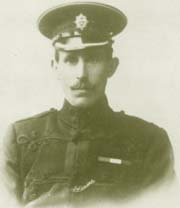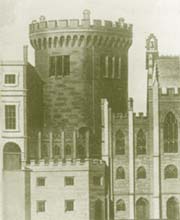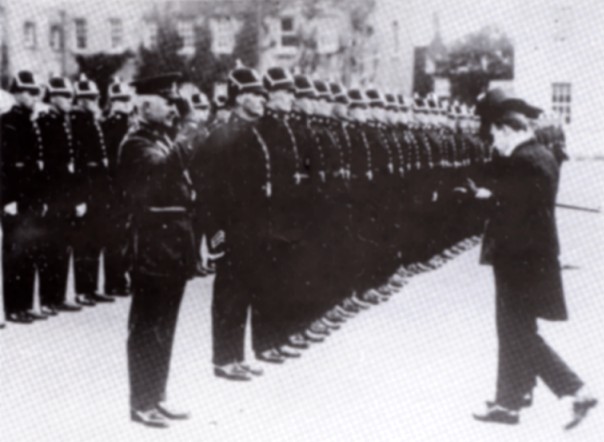
Inspector Robert Parks DMP c.1923 |
The Police organisation in the Dublin Metropolitan Area before the 18th century was very tenuous. For all practical purposes there were no police on duty by day, and by night there was an ineffective watch. The Watch system was based upon the twenty-one parishes into which the city was divided. Each parish nominated fifteen Watchmen to conduct tours of duty in their turn. A Constable who was nominated by the Church Wardens and parishioners supervised each of these groups. The hours of the night watch were 11 p.m. to 5 a.m. from April 1st., to Michaelmas Day each year and from 10 p.m. to 6 a.m. for the rest of the year.
In 1715 a Statute (2 George 1, Cap. 10, Irish) recited that these Watches were very weak and it was necessary to strengthen them. The Dublin Corporation was authorised to appoint Watchmen and Constables to keep the night Watches and an annual levy of 3d. in the £1 valuation was imposed.
This Statute did not improve the position very much. There were several amending statutes in the next sixteen years in an effort to improve the Watch system. In 1723 a Statute provided for the selection of directors and supervisors in each parish whose duty it was to arrange the number of Watchmen, their rates of pay and provision of arms. In 1765 the levy was raised to 1/- in the £1 on the valuation. The parish supervisors were given power to appoint three Inspectors in each parish who would be sworn in as Constables. Each Constable was to be paid no more than £10 per annum. In 1777 the inhabitants of each parish were authorised to elect from six to twelve persons from their members to form a Ward Mote Court; This Court in turn selected the Constables and Watchmen.

Record's Tower, Dublin Castle |
A Statute of 1786 (26 George III. Cap. 24, Irish) made an effort to reform the Dublin Police service. It formed a Dublin Metropolitan District consisting of the land inside the Circular Roads, and the land inside the walls of the Phoenix Park. The Lord Lieutenant was to nominate three magistrates who would be Commissioners of the Peace. These Commissioners were to have administrative functions in charge of the Police, and judicial functions as they sat as magistrates.
The Dublin Metropolitan District was divided into four Divisions. There was to be a High Constable of the whole District. The Commissioners were to appoint a Chief Constable and ten men in each Division who would be called Petty Constables, and whose duty it was to patrol the streets by day and by night. In addition they could appoint up to 400 night watchmen and 40 constables of the Watch. The Watch houses and the arms of the Force were vested in the Commissioners. The Commissioners were authorised to make an annual levy on householders for the maintenance of the Watch houses, arms and accoutrements.
In 1798 there were 48 Peace Officers and six Office Constables at a salary of £40 per annum, 32 Watch Constable at £30 per annum each and from 450 to 600 Watchmen at 1/1d per night.
In 1808, a further effort was made to improve the system. They increased the numbers of Divisions to six. They fixed a salary of £138 per annum for the Chief Constable; £36 per annum for the Office Constable; £33 per annum for a Constable and £24 per annum for a Watchman.
The Reform of 1836
"An Act for improving Police in the District of Dublin Metropolis 1836"
On the 4th July 1836, the above Act (6 and 7 William IV, Chap 29) was to transform policing in Dublin on the same lines as the re-organisation of the London Metropolitan Police which Sir Robert Peel had carried out in 1829. The new Force was to be under the direction of the Chief Secretary for Ireland. The Under Secretary at this time was one Thomas Drummond who pioneered this watershed in police reform, not just in Dublin but throughout Ireland with his Constabulary Act of 1836

Justice Minister Kevin O'Higgins about to inspect a Guard of Honour of D.M.P. members to mark the amalgamation of the D.M.P. with An Garda Síochána, April 1925. |
A new Police Office was to be established at No. 20 Dame Street and later in the Lower Yard of Dublin Castle. The new force would be under the control of two Justices of the Peace who would act as Joint Commissioners and be appointed by the Lord Lieutenant. Pensions were provided for any members of the existing Watch Force who were retired as a result of the passing of the new Act.
After its formation, the Dublin Metropolitan Police Force continued to function up to 1922. It was taken over by the Free State Government and re-named "Poilini Ath Cliath" in 1922 and amalgamated with the new Garda Síochána in April 1925 under the terms of the Police Forces Amalgamation Act 1925 (No. 7 of 1925).
Dublin Metropolitan Police (1836-1925)
|
JOINT AND CHIEF COMMISSIONERS |
| 1836-1871 | John Lewis MORE-O'FERRALL D.L., M.A.
Joint Commissioner |
| 1836-1837 | Lieut. Gen. Agustus CUYLER
Joint Commissioner |
| 1837-1858 | Major George Baxter BROWNE
Joint Commissioner |
| 1871-1883 | Colonel Henry Atwell LAKE, C.B.
Chief Commissioner |
| 1877-1883 | Captain George TALBOT C.B.
Chief Commissioner |
| 1883-1893 | Sir David HARREL K.C.B., K.C.V.O., P.C.
Chief Commissioner |
| 1893-1901 | John Joseph CASIMIR JONES C.B.
Chief Commissioner |
| 1901-1914 | Lieut. Col. Sir John Foster G. ROSS of Bladensburg K.C.B.
Chief Commissioner |
| 1914-1923 | Lieut. Col. Sir Walter EDGEWORTH-JOHNSTON C.B.
Chief Commissioner |
| 1915-1920 | William Moorehouse DAVIES
Joint Assistant Commissioner |
| 1915-1920 | Fergus QUINN
Joint Assistant Commissioner |
| 1923-1925 | Major General William Richard ENGLISH-MURPHY D.S.O., M.C., M.A.
Chief Commissioner |
| ASSISTANT COMMISSIONERS |
| 1877-1883 | Lieut. Col. John Agustus CONNOLLY V.C.
Assistant Commissioner |
| 1893-1903 | John MALLON
Assistant Commissioner |
| 1902-1914 | William Vesey HARREL C.B., C.B.E., M.V.O.
Assistant Commissioner |
| 1920 | William C. FORBES-REDMOND
Assistant Commissioner |
| 1920-1925 | Denis BARRETT
Assistant Commissioner |
The most notable among this list of distinguished names from a civil police prospective must be that of Assistant Commissioner John Mallon from Furrybridge, Co. Armagh. He proved to be perhaps one of the best detectives of his time in the world of civil policing. His investigation of the Phoenix Park murders in the 1880's, which led to the conviction of "the lnvincibles" in 1883, was perhaps one of his better known achievements.
Copyright © 2000 Garda Síochána Museum/Archives
|